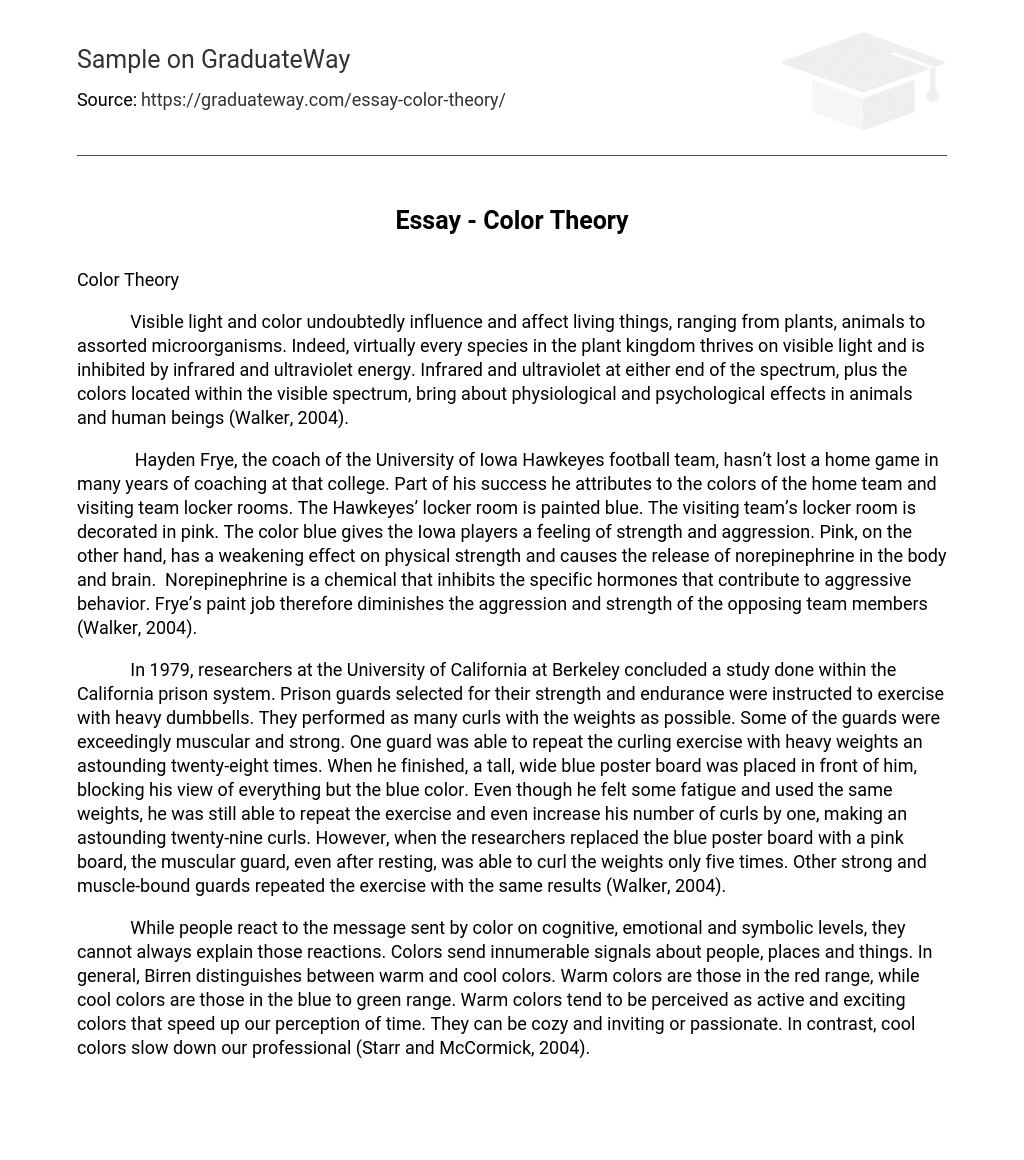Color Theory
Visible light and color undoubtedly influence and affect living things, ranging from plants, animals to assorted microorganisms. Indeed, virtually every species in the plant kingdom thrives on visible light and is inhibited by infrared and ultraviolet energy. Infrared and ultraviolet at either end of the spectrum, plus the colors located within the visible spectrum, bring about physiological and psychological effects in animals and human beings (Walker, 2004).
Hayden Frye, the coach of the University of Iowa Hawkeyes football team, hasn’t lost a home game in many years of coaching at that college. Part of his success he attributes to the colors of the home team and visiting team locker rooms. The Hawkeyes’ locker room is painted blue. The visiting team’s locker room is decorated in pink. The color blue gives the Iowa players a feeling of strength and aggression. Pink, on the other hand, has a weakening effect on physical strength and causes the release of norepinephrine in the body and brain. Norepinephrine is a chemical that inhibits the specific hormones that contribute to aggressive behavior. Frye’s paint job therefore diminishes the aggression and strength of the opposing team members (Walker, 2004).
In 1979, researchers at the University of California at Berkeley concluded a study done within the California prison system. Prison guards selected for their strength and endurance were instructed to exercise with heavy dumbbells. They performed as many curls with the weights as possible. Some of the guards were exceedingly muscular and strong. One guard was able to repeat the curling exercise with heavy weights an astounding twenty-eight times. When he finished, a tall, wide blue poster board was placed in front of him, blocking his view of everything but the blue color. Even though he felt some fatigue and used the same weights, he was still able to repeat the exercise and even increase his number of curls by one, making an astounding twenty-nine curls. However, when the researchers replaced the blue poster board with a pink board, the muscular guard, even after resting, was able to curl the weights only five times. Other strong and muscle-bound guards repeated the exercise with the same results (Walker, 2004).
While people react to the message sent by color on cognitive, emotional and symbolic levels, they cannot always explain those reactions. Colors send innumerable signals about people, places and things. In general, Birren distinguishes between warm and cool colors. Warm colors are those in the red range, while cool colors are those in the blue to green range. Warm colors tend to be perceived as active and exciting colors that speed up our perception of time. They can be cozy and inviting or passionate. In contrast, cool colors slow down our professional (Starr and McCormick, 2004).
Red is a powerful color associated with vitality, energy and ambition. It is an action color that prompts people to pay attention and react. Pink on the other hand, is a lighter shade of red, rather than being a color in and of itself. Research reported on the previous example that pink can have a weakening or calming effect that helps relax muscles. Pink has a more calming and soothing effect than do other warm colors. Chiazzari reports that pink also helps people feel protected and nurtured. Orange is an uplifting, energetic color that jovially conveys warmth. It is associated with Halloween, Thanksgiving and autumn. Birren reports that it is a social, cheerful color. Chiazarri and Birren describe orange as having a stimulating effect on the gastric system. Indeed, architects and interior designers often recommend orange for dining rooms or cafes because of its effect on digestion. However, orange is not a serious color and as a result can be seen as superficial. Orange also symbolized caution. Being symbolically associated with Halloween, orange can also convey distrust, as it symbolically represents deceit (Starr and McCormick, 2004).
Luscher describes yellow as a bright, stimulating color. His research shows that like exposing people to red, exposing people to the color yellow increases blood pressure, pulse rates and respiration rates. Moreover, yellow affects the sympathetic nervous system. Symbolically, yellow is the color of energetic thought. It stimulates discrimination, memory, clear thinking, decision making and good, reason-based judgment. Yellow is color of summer and sunlight. It is optimistic and joyous. However, yellow may also symbolize cowardice, prejudice and fear. On the other hand, as one of the cooler colors, green conveys peace, quiet and relaxation and can make people feel lazy. It symbolizes being socially well adjusted, and is preferred by those who belong to clubs or undertake civil duties (Starr and McCormick, 2004).
Indigo is the color for insight and intuitive wisdom. In addition to this, it presents the human mind with the deepest reality of beauty and truth in everything. Purple or violet on the other hand is the color for connectedness to transcendent spirit and the feeling of being at home in the cosmos. It also allows the human mind to feel freedom and oneness (Bennett, 2004).
Color in general, is fundamental to virtually every facet of life. Yet the way one individual perceives a color may be different from another individual’s perception. In addition to this, color sets a mood. Mood effects and color psychology should be carefully considered as to effect the desired message. When you combine colors creatively, you can portray themes, convey ideas, and stimulate other individuals to take action (Kupsh and Graves, 1993).
References
Bennet, R.R. (2004). Healing Magic: A Green Witch Guidebook. New York: Sterling Publishing Company, Inc.
Kupsh, J. and P.R. Graves. (1993). Here’s How: Create High-Impact Business Presentations. Chicago: NTC/Contemporary Publishing Company.
Starr, H. and M. McCormick. (2004). Jury Selection: An Attorney’s Guide to Jury Law and Methods. New York: Aspen Publishers.
Walker, Morton. (2004). The Power of Color. New York: Avery Publishing Group, Inc.





